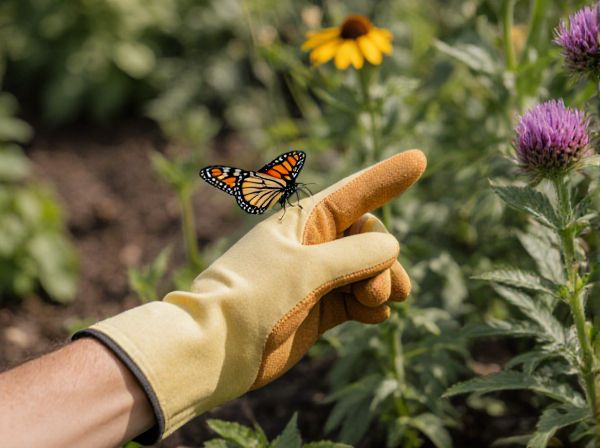
Day Pollination vs Night Pollination Illustration
Day pollination primarily involves bees, butterflies, and birds that are active during daylight hours, facilitating the transfer of pollen through visual and olfactory cues. Night pollination relies on nocturnal creatures like moths and bats, which are attracted to pale or white flowers with strong scents that are easier to detect in the dark. Both processes are crucial for biodiversity and crop production, supporting different plant species adapted to specific pollination times.
Table of Comparison
| Aspect | Day Pollination | Night Pollination |
|---|---|---|
| Active Pollinators | Bees, butterflies, birds | Moths, bats, beetles |
| Pollination Time | Sunrise to sunset | Sunset to sunrise |
| Flower Traits | Bright colors, strong scents | Pale or white, strong night fragrance |
| Pollination Efficiency | High in sunlight conditions | Effective in low light or dark |
| Ecological Role | Supports diurnal biodiversity | Supports nocturnal ecosystems |
Understanding Day vs Night Pollinators
Day pollination primarily involves diurnal pollinators such as bees, butterflies, and hummingbirds, which rely on visual cues like bright colors and floral scents to locate flowers. Night pollination is dominated by nocturnal pollinators including moths, bats, and some beetles that depend on olfactory signals and pale or white flowers that reflect low light. Understanding the distinct behaviors, sensory adaptations, and active periods of day versus night pollinators helps optimize plant-pollinator interactions for effective pollination and biodiversity conservation.
Key Differences in Day and Night Pollination
Day pollination primarily involves diurnal pollinators such as bees, butterflies, and hummingbirds that rely on visual cues like bright flower colors and scent to locate nectar. Night pollination is dominated by nocturnal pollinators such as moths and bats, which use olfactory signals and pale or white flowers to identify suitable plants in low-light conditions. These differences influence plant adaptations, including flower morphology, scent production, and nectar availability, optimizing pollination success across different times of the day.
Important Daytime Pollinators: Bees, Butterflies, and More
Bees, butterflies, and other diurnal insects play a crucial role in daytime pollination, facilitating the transfer of pollen from one flower to another, which is essential for plant reproduction and biodiversity. These pollinators are attracted by bright colors and scents of flowers that bloom during daylight hours, enhancing pollination efficiency and crop yields. Their activity supports ecosystems and agricultural productivity by ensuring genetic diversity and fruit formation in many plant species.
Nocturnal Pollinators: Moths, Bats, and Beyond
Nocturnal pollinators like moths and bats play a crucial role in night pollination by transferring pollen in the absence of daylight, ensuring the reproduction of many plant species with nocturnally blooming flowers. Moths are particularly attracted to white or pale flowers with strong fragrances, while bats favor large, sturdy flowers that provide ample nectar. This night pollination complements diurnal pollination patterns, maintaining biodiversity and ecosystem stability.
How Flowers Adapt to Day and Night Pollinators
Flowers adapted to day pollination typically exhibit bright colors, strong fragrances, and open structures that attract visually oriented pollinators like bees and butterflies. Night-pollinated flowers often have pale or white petals, emit stronger scents at dusk, and open or release nectar during nighttime to appeal to nocturnal pollinators such as moths and bats. These specialized adaptations enhance reproductive success by aligning with the activity patterns and sensory capabilities of their primary pollinators.
Environmental Factors Influencing Pollination Timing
Day pollination primarily depends on visual cues like bright sunlight and warm temperatures that activate diurnal pollinators such as bees and butterflies. In contrast, night pollination relies on factors like cooler temperatures, nocturnal floral scents, and moonlight to attract moths and bats. Environmental elements including ambient light, temperature fluctuations, and humidity play crucial roles in determining the timing and efficiency of pollination activities.
Benefits and Limitations of Day and Night Pollination
Day pollination benefits include higher visibility for pollinators like bees and butterflies, leading to increased flower visitation rates and enhanced cross-pollination efficiency. Limitations involve vulnerability to weather changes and predation risks during daylight hours. Night pollination, primarily by moths and bats, benefits nocturnal plants adapted to cooler temperatures and reduced competition, but faces constraints such as fewer pollinator species and limited flower scent dispersion.
Impact on Crop Yields and Garden Health
Day pollination by bees, butterflies, and other diurnal insects significantly boosts crop yields by enhancing fruit set and quality in sunlit environments. Night pollination, primarily carried out by moths and bats, supports crop health by enabling pollination of nocturnal flowers and maintaining biodiversity crucial for garden resilience. Combining both day and night pollination optimizes overall ecosystem services, improves garden health, and ensures consistent crop productivity across diverse plant species.
Supporting Both Day and Night Pollinators in Your Garden
Supporting both day and night pollinators in your garden enhances biodiversity and boosts plant health by ensuring continuous pollination. Incorporate a variety of native flowering plants that bloom at different times, providing essential nectar and pollen sources for bees, butterflies, moths, and bats. Installing features like soft lighting and sheltered resting spots encourages nocturnal pollinators while maintaining a pollinator-friendly habitat during daylight hours.
Future Trends in Pollinator Conservation and Research
Future trends in pollinator conservation emphasize enhancing habitat diversity to support both day and night pollinators, including bees, butterflies, moths, and bats. Advances in technology, such as infrared imaging and molecular analysis, improve the understanding of nocturnal pollination networks and their impact on crop yields. Integrating these insights drives innovation in sustainable agriculture and biodiversity preservation strategies tailored to diurnal and nocturnal pollinator behaviors.
Day Pollination vs Night Pollination Infographic

 gardendif.com
gardendif.com